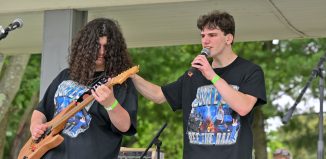Long Island skeleton racer wins World Cup gold
Skeleton racer nabs first place in 2016 IBSF World Cup race in Lake Placid

On her home track in Lake Placid, Port Jefferson Station’s Annie O’Shea won her first gold medal in a World Cup skeleton race.
O’Shea scored a combined time of 1 minute, 50.34 seconds, beating out Switzerland’s Marina Gilardoni by 0.09 seconds for the top spot. O’Shea slid down the track in a time of 55.26 seconds in her first heat, which was good enough for third place, a tenth of a second behind the leaders. She followed that up with a time of 55.08 seconds in her second run, tying a track record.

“I wanted this for so long,” O’Shea said. “Everything I’ve done these past 10 year — to become better and work on myself and the process, has paid off.”
After her second run at the 2016 International Bobsleigh & Skeleton Federation World Cup event on Jan. 8, O’Shea stood at the bottom of the mountain watching as the only two racers who could beat her time took their turns. When she saw that she’d won, her jaw dropped as she leaped in the air before hugging her assistant scouting coach, Zach Lund.
“I started crying at the bottom and I couldn’t stop,” she said. After the awards ceremony, O’Shea stopped to sign autographs for young fans.
The Port Jefferson Station athlete, who graduated from Comsewogue and was a 2004 outdoor track and field state champion in the pentathlon when she attended SUNY Plattsburgh, had been ranked 11th in the world coming into this World Cup event in Lake Placid, which is home to the “Miracle on Ice” USA men’s ice hockey team that won a gold medal in the 1980 Winter Olympics.
O’Shea said she appreciates the consistent support from her family, friends and community.
“It’s nice to feel when you go home that people kind of have a place for you or are cheering for you,” she said.
O’Shea had previously won a silver medal in December of 2011 in La Plagne, France. This, however, is her first gold at this level of competition.
Tuffy Latour, the head coach of the skeleton team, said O’Shea has been building towards this moment for several years, and has come on strong this year.
“Her potential [has been] through the roof,” Latour said. “It was kind of story book for her. She [was in] third and then put down a very fast heat.”

Her mother, Linda, watched the race at her desk in the Comsewogue School District’s district office. She said she jumped out of her seat and cheered with one of her colleagues who watched the finish with her, drawing a crowd of people to her desk, who were quick to share I the excitement.
“I’m so proud of her,” Linda O’Shea said. “It’s the perfect start to a new year.”
Competitors in skeleton use the same curved ice track as racers in luge and bobsled. Bent over and holding onto the sides of their sleds, they sprint for five to six seconds, then dive headfirst onto their sleds. Clad in aerodynamic suits, they slide down the track at speeds of over 80 miles per hour, banking through turns with slight shifts of their body weight.
The next World Cup skeleton race will take place in Park City, Utah on Jan. 15th and 16th. The World Cup races are the second-largest events in the sport behind the Olympics. The skeleton team is currently preparing for the 2018 games in PyeongChang, South Korea.






